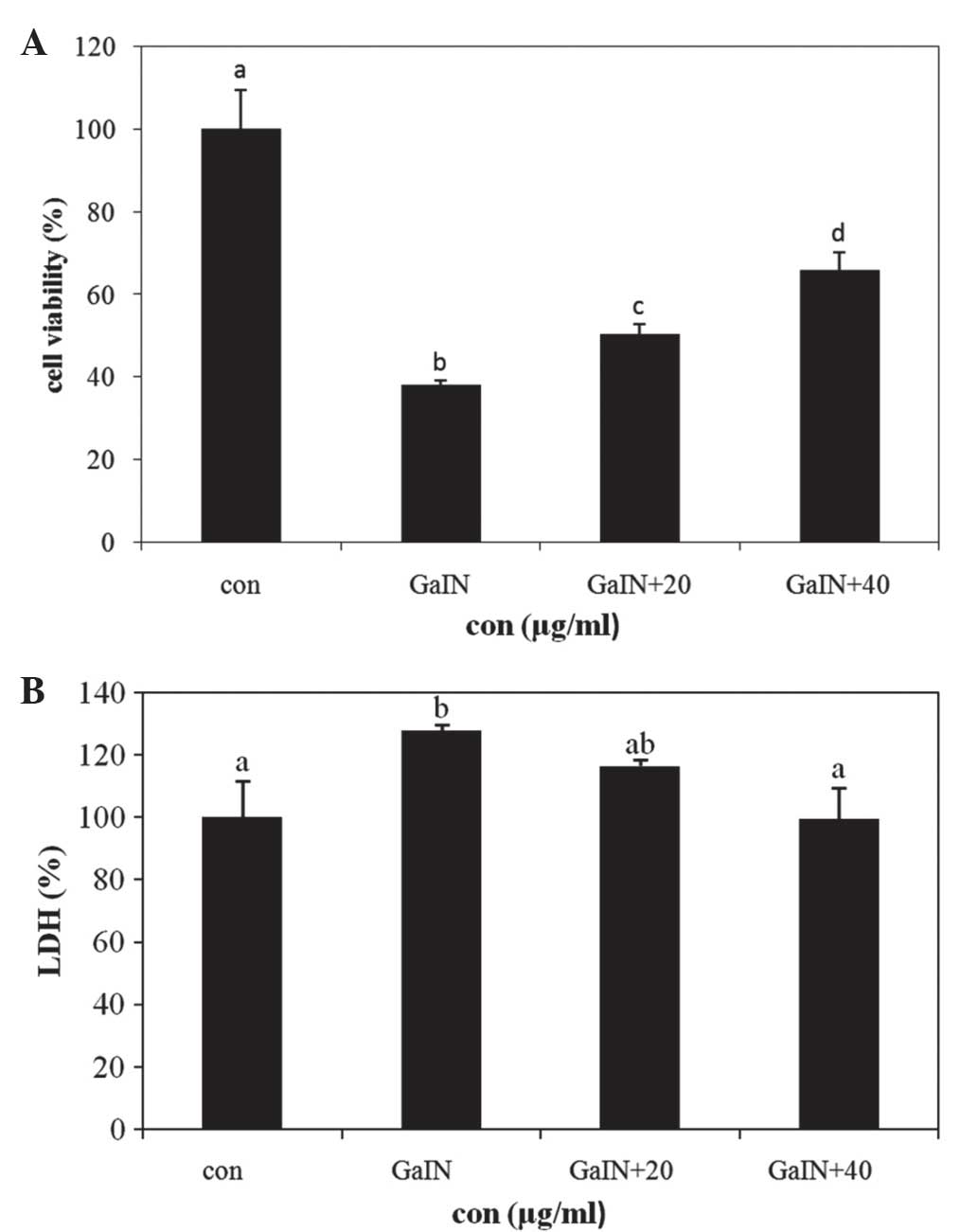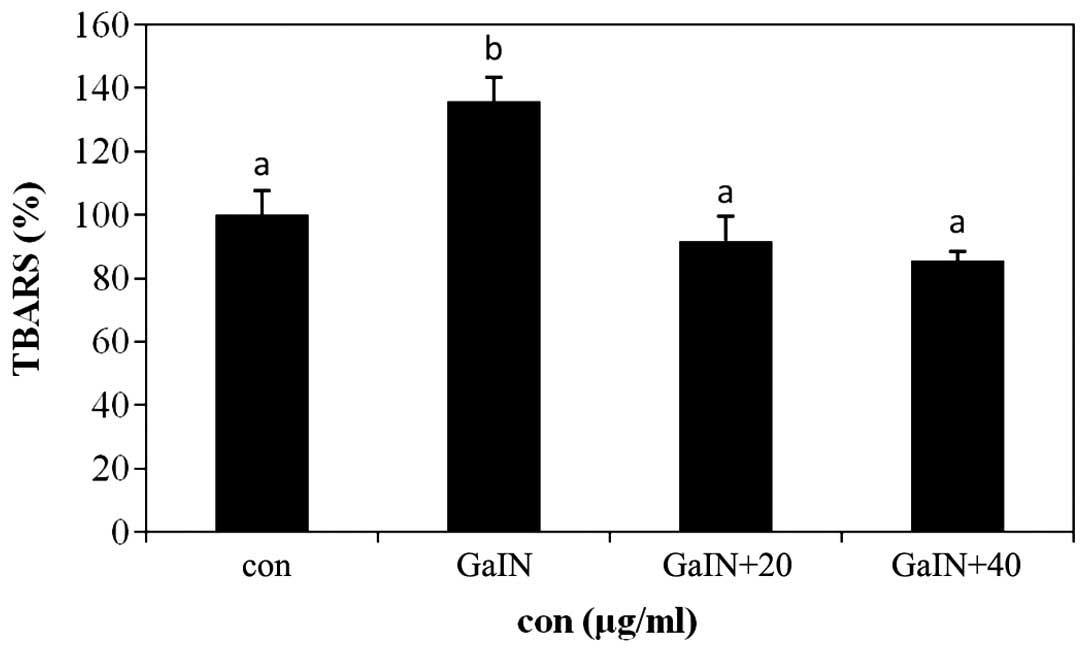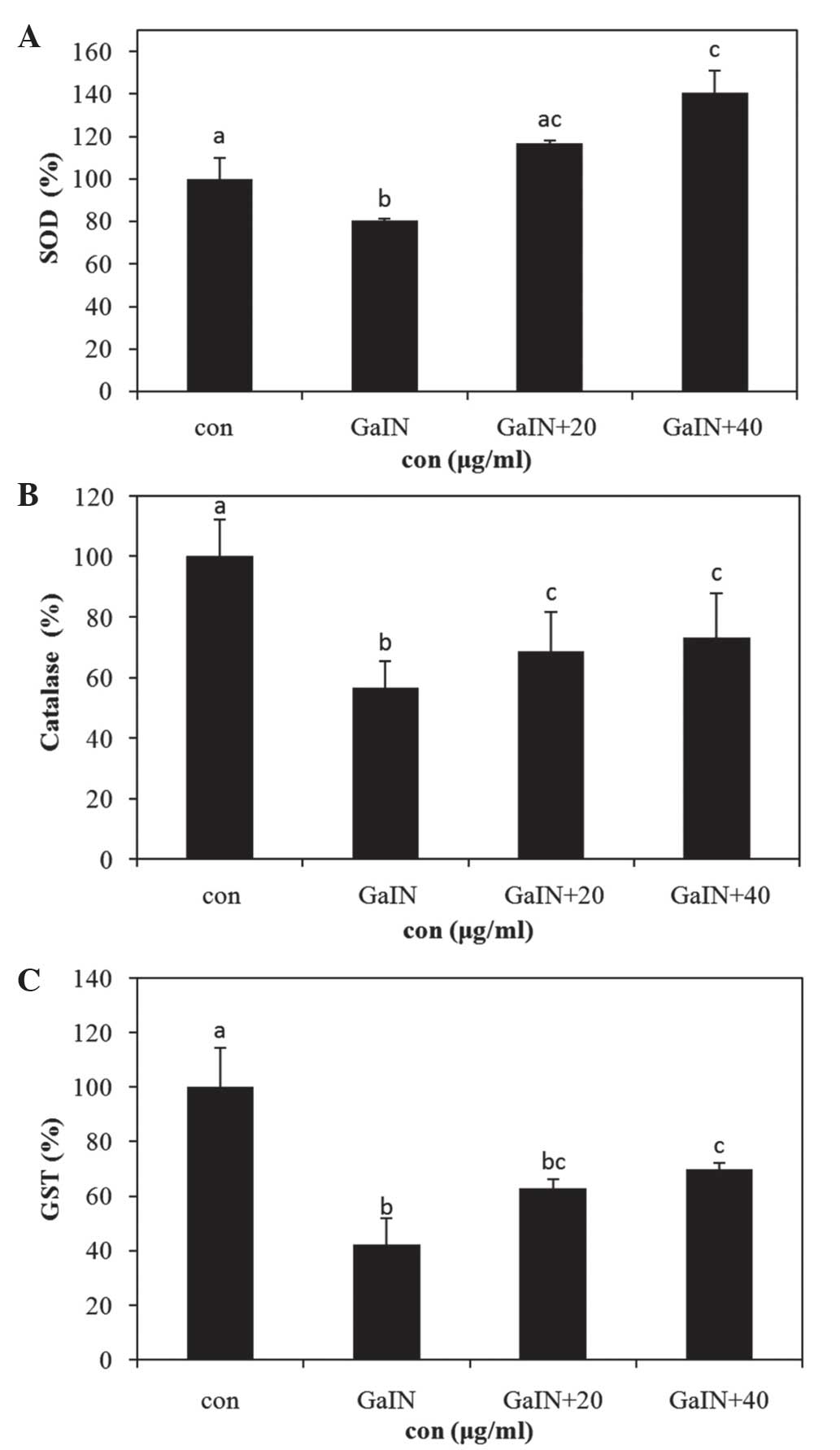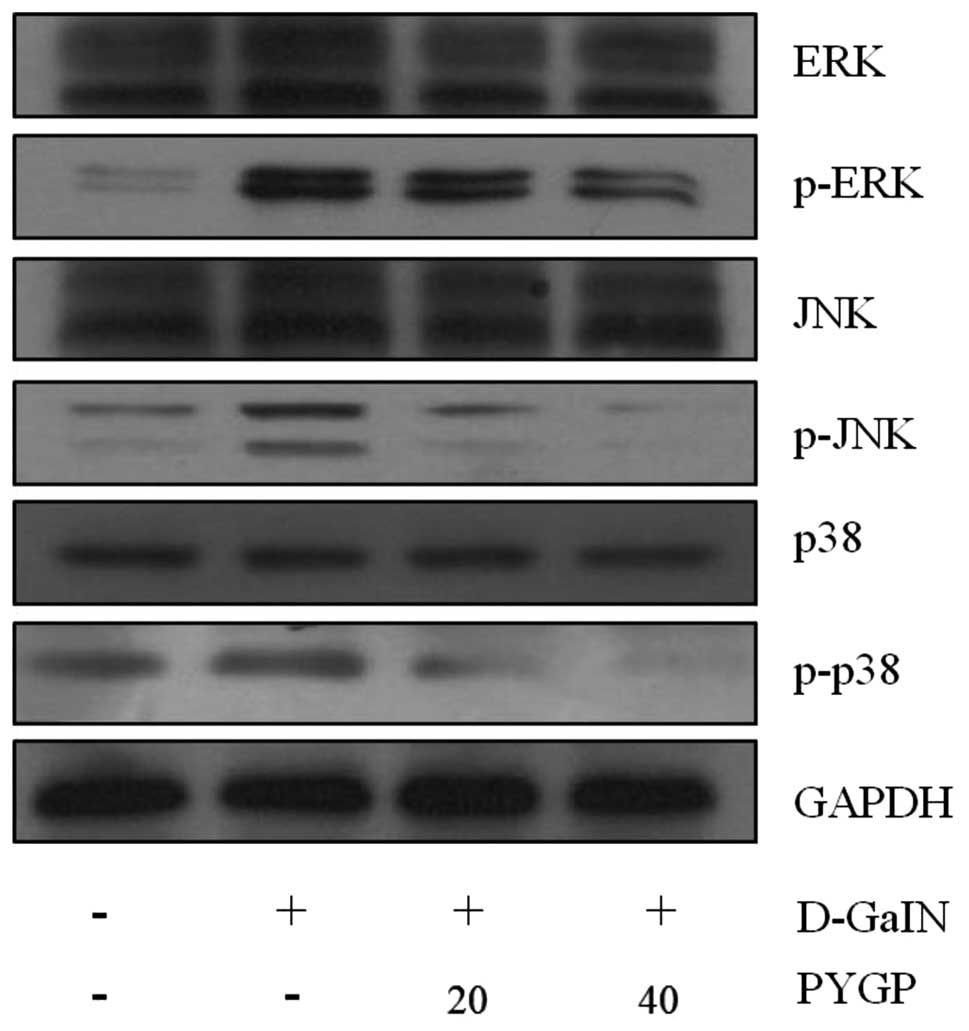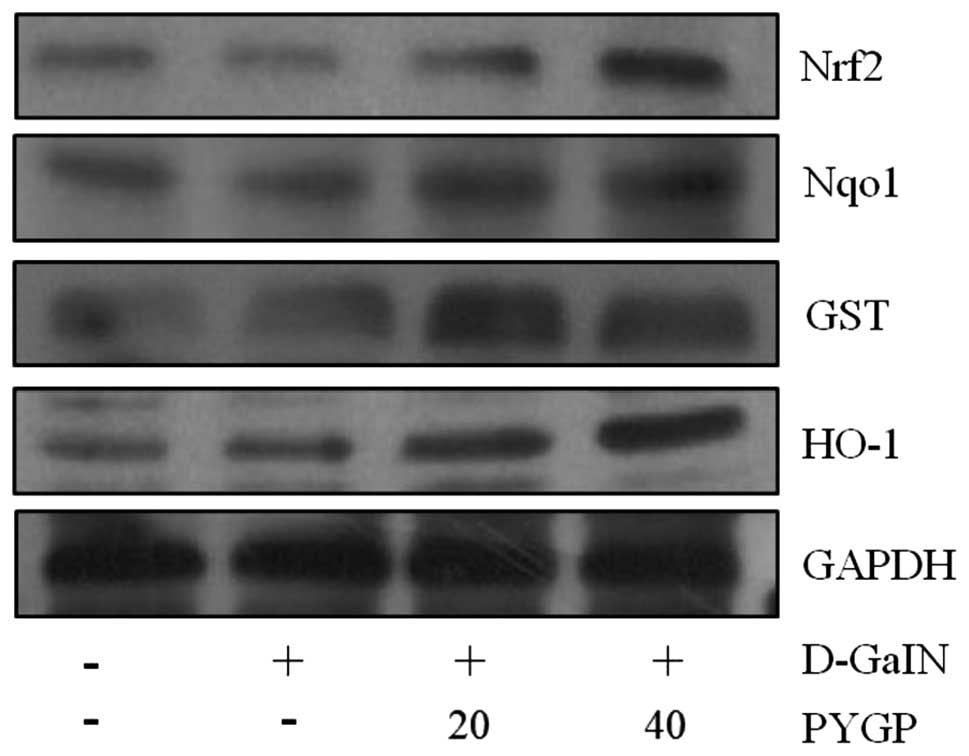Protective effect of Porphyra yezoensis glycoprotein on D-galactosamine‑induced cytotoxicity in Hepa 1c1c7 cells
- Authors:
- Published online on: January 23, 2015 https://doi.org/10.3892/mmr.2015.3244
- Pages: 3914-3919
Abstract
Introduction
Liver disease is a prevalent medical condition which has numerous etiologies, including chemical exposure, alcohol, lipid peroxidative products and viral infection (1). To date, several types of medications have been investigated for the treatment of liver diseases (2).
D-galactosamine (D-GaIN) is a well-known inducer of hepatic injury in vitro and in vivo. D-GaIN treatment results in the loss of uridine 5′-triphosphate, uridine 5′-diphosphate and uridine 5′-monophosphate as well as inhibition of RNA and protein synthesis (3). In addition, D-GaIN-induced oxidative stress is generated through reactive hydroxyl radical damage to the cell membrane via stimulation of lipid peroxidation (4). Several studies have shown that D-GaIN-induced hepatocyte death was mediated through mitogen-activated protein kinase (MAPK) and nuclear factor erythroid 2-related factor 2 (Nrf2) signaling (5–7).
Nrf2 is a transcription factor which targets certain genes, including those for nicotinamide adenine dinucleotide phosphate hydrogen (NADPH), quinine oxidoreductase 1 (Nqo1), glutathione (GSH) synthesis and glutathione-s-transferase (GST) (8); in addition, Nrf2 has been shown to have protective effects against oxidative stress (9). During oxidative stress, Nrf2 translocates to the nucleus from the cytosol, and as a result, antioxidant enzymes become upregulated and oxidative stress damage decreases (10).
MAPKs include c-jun N-terminal kinase (JNK), p38 MAPK and extracellular signal-regulated kinase (ERK). These proteins have been reported to be phosphorylated via GaIN-induced oxidative stress (5). Of note, activated-JNK induces hepatocyte death and apoptosis via activation of caspase-3 as well as liver cell necrosis (11).
Superoxide dismutase (SOD) and catalase (CAT) are important cellular defense systems which transform superoxide into oxygen and hydrogen peroxide for detoxification (12). In addition, GSTs are a superfamily of enzymes that protect against chemical toxicity and oxidative stress (13,14). Porphyra (P.) yezoensis is a red algae found along the coasts of Korea, China and Japan. In the present study, the protective effect of Porphyra yezoensis glycoprotein (PYGP) on D-GaIN-induced cytotoxicity was investigated in Hepa 1c1c7 cells.
Materials and methods
Preparation of PYGP
P. yezoensis was purchased in 2013 in the Republic of Korea (Shuyup, Busan, Korea). P. yezoensis powder (40 g) was suspended in 1 l distilled water and stirred for 4 h at room temperature. The suspension was centrifuged at 3,000 × g at 4°C for 20 min and vacuum filtered, followed by the addition of triple volumes (total quantity of filtrate × 3) of ethanol. Following 24 h, the solution was filtered and concentrated using rotary evaporation at 40°C. The concentrated solution was divided into 1.5-ml tubes, freeze-dried and stored at −70°C until further use.
Cell culture
Normal mouse Hepa 1c1c7 hepatocyte cells (no. 22026) were purchased from the Korean Cell Line Bank (Seoul, Korea). Cells were maintained at 37°C in a 5% CO2 humidified atmosphere. Hepa 1c1c-7 cells were cultured in minimum essential medium α (Gibco-BRL, Grand Island, NY, USA) without nucleosides supplemented with 10% fetal bovine serum (FBS; Hyclone Laboratories, Inc., Logan, UT, USA) and antibiotics (Gibco-BRL). The medium was replaced every two days.
Cell proliferation
Hepa 1c1c7 cell proliferation was measured using a CellTiter 96 aqueous non-radioactivity cell proliferation assay (Promega Corp., Madison, WI, USA). This assay determines cell proliferation based on the cleavage of 3-(4,5-dimethylthiazol-2-yl)-5-(3-carboxymethoxy-phenyl)-2-(4-sulfonyl)-2H-tetrazolium (MTS) into a formazan product, which is soluble in tissue culture medium. Hepa 1c1c7 cells were seeded onto 96-well plates at a density of 1.5×103 cells/well in 100 μl medium. Cells were cultured for 24 h, following which the medium was replaced with serum-free medium (SFM) containing PYGP (20 or 40 μg/ml) for 24 h. PYGP-treated Hepa 1c1c7 cells were then exposed to 20 mM D-GaIN (Sigma-Aldrich, St. Louis, MO, USA) for 24 h. Subsequently, cells were incubated in MTS solution for 30 min at 37°C. Cell proliferation was measured at 490 nm using a Benchmark Plus 10730 microplate reader (Benchmark; Bio-Rad Laboratories, Inc., Hercules, CA, USA).
Estimation of dehydrogenase release
Hepa 1c1c7 cell injury was quantitatively assessed via determination of lactate dehydrogenase (LDH), which is released from damaged or destroyed cells. Hepa 1c1c7 cells were seeded onto 96-well plates at a density of 1.5×103 cells/well in 100 μl medium. Cells were cultured for 24 h, following which the SFM was replaced with PYGP (20 or 40 μg/ml) for 24 h. Hepa 1c1c7 cells were then exposed to either D-GaIN (20 mM) with PYGP (20 or 40 μg/ml) for 24 h. LDH release was measured using an LDH cytotoxicity assay kit according to the manufacturer’s instructions (Cayman Chemical Co., Ann Arbor, MI, USA). Absorbance was then measured at 490 nm using a Benchmark Plus 10730 microplate reader (Bio-Rad Laboratories, Inc.).
Lipid peroxidation measurement
Cells were collected in lysis buffer (phosphate-buffered saline, 0.05% butyl hydroxyl toluene; Cell Biolabs Inc., San Diego, CA, USA) and homogenized on ice using a thiobarbituric acid reactive substances (TBARS) assay kit (Cell Biolabs, Inc.) according to the manufacturer’s instructions. Absorbance was then measured at 532 nm using a Benchmark Plus 10730 microplate reader (Bio-Rad Laboratories, Inc.).
Western blot analysis
Hepa 1c1c7 cells were plated onto 100-mm dishes. Cells were cultured until they reached 60–80% confluence and were then pre-treated with PYGP (20 or 40 μg/ml) for 24 h. Cells were then exposed to D-GaIN (20 mM) with PYGP (20 or 40 μg/ml) for 24 h. Cells were washed with ice-cold phosphate-buffered saline (PBS; 0.15 M sodium phosphate, 0.15 M sodium chloride, pH 7.4; Gibco-BRL), following which lysis buffer [20 mM Tris-base (pH 7.5), 150 mM NaCl, 0.25% Na-deoxycholate, 1 mM EDTA, 1 mM ethylene glycol tetraacetic acid, 1% Triton X-100 from iNtRON Biotechnology, Seoul, Korea; containing 2.5 M sodium pyrophosphate, 1 mM β-glycerophosphate, 1 mM Na3VO4, 1 μg/ml aprotinin, 1 μg/ml leupeptin, 1 μg/ml pepstatin A and 1 mM phenylmethylsulfonyl fluoride from Sigma-Aldrich] was added. Protein content was determined using a bicinchoninic acid protein assay kit (Pierce Biotechnology, Inc., Rockford, IL, USA). Proteins were separated using 10–15% SDS-PAGE and then transferred to a polyvinylidene fluoride membrane (Millipore, Billerica, MA, USA). The transferred membrane was blocked at room temperature with 1% bovine serum albumin (BSA) in Tris-buffered saline with Tween 20 [TBS-T; 10 mM Tris-HCl (pH 7.5), 150 mM NaCl and 0.1% Tween 20] and then incubated, with agitation, with the indicated primary antibodies: Rabbit anti-mouse ERK immunoglobulin G (IgG) polyclonal antibody [diluted 1:1,000 with BSA/TBS-T; incubated for 4 h at room temperature (RT)], rabbit anti-phosphorylated (p)-ERK IgG polyclonal antibody (diluted 1:1,000 with BSA/TBS-T; incubated for 4 h at RT), mouse anti-mouse JNK IgG monoclonal antibody (diluted 1:1,000 with BSA/TBS-T; incubated for 4 h at RT), mouse anti-mouse p-JNK IgG monoclonal antibody (diluted 1:1,000 with BSA/TBS-T; incubated for 4 h at RT), rabbit anti-mouse p38 IgG polyclonal antibody (diluted 1:1,000 with BSA/TBS-T; incubated for 4 h at RT), mouse anti-mouse p-p38 IgG monoclonal antibody (diluted 1:1,000 with BSA/TBS-T; incubated for 4 h at RT), rabbit anti-mouse Nrf2 IgG polyclonal antibody (diluted 1:1,000 with BSA/TBS-T; incubated for 4 h at RT), goat anti-mouse Nqo1 IgG polyclonal antibody (diluted 1:1,000 with BSA/TBS-T; incubated for 4 h at RT), mouse anti-mouse GST IgG monoclonal antibody (diluted 1:1,000 with BSA/TBS-T; incubated for 4 h at RT), and rabbit anti-mouse heme oxygenase (HO)-1 IgG polyclonal antibody (diluted 1:1,000 with BSA/TBS-T; incubated for 4 h at RT), which were all purchased from Santa Cruz Biotechnology, Inc. (Dallas, TX, USA). The secondary antibody was a peroxidase-conjugated goat, mouse and rabbit antibody (1:10,000; GE Healthcare, Little Chalfont, UK). Super Signal West Pico Stable Peroxide Solution and the Super Signal West Pico Luminol/Enhancer solution (Thermo Fisher Scientific, Rockford, IL, USA) were then added and the signal was monitored using X-ray film (Kodak, Rochester, NY, USA) and a developer and fixer twin pack (Kodak).
Antioxidant enzyme measurement
SOD (Superoxide dismutase assay kit; Cayman Chemical Co., Ann Arbor, MI, USA), CAT (Catalase assay kit; Cayman Chemical Co.) and GST (Glutathione s-transferase assay kit; Cayman Chemical Co.) activities of Hepa 1c1c7 cells were measured according to the manufacturer’s instructions. Absorbance was then measured using a Benchmark microplate reader (Benchmark Plus 10730; Bio-Rad Laboratories, Inc.).
Statistical analysis
Values are presented as the mean ± standard deviation and data were analyzed with SPSS 10.0 software (SPSS, Inc., Chicago, IL, USA) using an analysis of variance followed by a Duncan’s multiple range test. P<0.05 was considered to indicate a statistically significant difference between values.
Results
Protective effects of PYGP against D-GaIN-induced injury in Hepa 1c1c7 cells
The protective effect of PYGP against D-GaIN-induced hepatotoxicity in normal mouse liver cells was measured using the MTS cell viability assay. Cells were pre-treated with PYGP for 24 h and then incubated with D-GaIN and PYGP for 24 h. The results of the MTS assay showed that D-GaIN treatment induced Hepa 1c1c7 cell death, whereas pretreatment with PYGP significantly attenuated the cytotoxic effects of D-GaIN (P<0.05; Fig. 1A).
LDH is a soluble enzyme located in the cytosol, which is released into the surrounding culture medium upon cell damage (15,16). The results of the present study demonstrated that the D-GaIN-only treatment group showed increased LDH levels compared with those of the control group; by contrast, the PYGP pre-treatment groups showed significantly decreased LDH enzyme release compared with that of the D-GaIN-only treatment group (P<0.05; Fig. 1B).
Inhibitory effect of Hepa 1c1c7 cells on TBARS production using PYGP
Lipid peroxidation induces TBARS generation and cell damage through oxidative stress; in addition, TBARS and lipid peroxide produced during oxidative stress may cause or aggravate diseases associated with aging and hepatotoxicity (17). The results of the present study revealed that levels of TBARS were increased in the D-GaIN-only treatment group compared with those of the control group. In addition, pre-treatment with PYGP significantly inhibited the D-GaIN-induced increase in TBARS levels (P<0.05; Fig. 2).
Increased antioxidant enzyme activity in Hepa 1c1c7 cells in the presence of PYGP
CAT, SOD and GST are the primary defensive enzymatic antioxidants in eukaryotic cells (18). The activity levels of these enzymes were all found to be significantly inhibited in the D-GaIN-only treatment group compared with those in the control group. By contrast, the PYGP pre-treatment group showed increased antioxidant enzyme activity compared with that in the D-GaIN-only treatment group (P<0.05; Fig. 3).
Effect of PYGP pre-treatment on GaIN-induced expression and phosphorlyation of via MAPKs
ERK, JNK and p38 MAPK are known to be phosphorylated and activated in response to D-GaIN (11). In the present study, the phosphorylation of each MAPK was examined using western blot analysis. The results revealed that PYGP suppressed the D-GaIN-induced activation of each MAPK; in addition, treatment with 40 μg/ml PYGP was observed to have a more suppressive effect compared with that of 20 μg/ml PYGP. However, total ERK, JNK and p38 MAPK protein expression levels were not altered following treatment with D-GaIN or PYGP pre-treatment (Fig. 4).
PYGP upregulates the Nrf2 signaling pathway
Nrf2 has previously been reported to increase the expression of various oxidant defense proteins, including HO-1, Nqo1 and GST (7,8). In the present study, western blot analysis was used to examine the expression of these proteins following D-GaIN-induced cell injury and pre-treatment with PYGP. Cells exposed to D-GaIN only showed reduced Nrf2, HO-1, Nqo1 and GST protein expression levels compared with those of the untreated cells. By contrast, the expression of these Nrf2-stimulated proteins following PYGP pre-treatment were significantly increased compared with those in the D-GaIN-only group (Fig. 5).
Discussion
In the present study, cytotoxic injury was induced in Hepa 1c1c7 cells using D-GaIN, which is a commonly used model for screening anti-hepatotoxic and anti-hepatoxic activities of drugs. D-GaIN-induced liver injury has previously been shown to closely resemble acute viral hepatitis (19,20). D-GaIN has direct and indirect roles, which affect the oxidative stress properties of organs. Several studies have shown that D-GaIN induced changes in liver antioxidant enzyme levels (17,21–23). In addition, D-GaIN was reported to induce hepatotoxicity by inhibiting RNA and protein synthesis as well as reducing uridine 5′-triphosphate, uridine 5′-diphosphate and uridine 5′-monophosphate levels (17,24,25). Increased LDH release into the medium as a result of cell damage is widely used as a measure of cytotoxicity (26). In the present study, D-GaIN treatment was found to induce cytotoxicity in Hepa 1c1c7 cells, the effect of which was attenuated in cells pre-treated with PYGP.
Peroxidation of endogenous lipids is a major factor affecting the cytotoxic activity of D-GaIN (7). D-GaIN-induced oxidative stress damage is generally attributed to the formation of highly reactive hydroxyl radicals, such as superoxide anions, which stimulate lipid peroxidation and damage cell membranes (4,27). In the present study, TBARS was significantly increased following D-GaIN-only treatment; however, pre-treatment with PYGP decreased the oxidative damage in cells, based on the decreased levels of TBARS compared to those in the D-GaIN-only group. SOD and CAT are first-line cellular antioxidant defense enzymes. SOD reacts with O2 in order to generate H2O2 and H2O (13), while CAT accelerates the dismutation reaction of H2O2 and the formation of H2O and O2 (28,29). GST binds to numerous different lipophilic drugs and chemicals; thus, it likely binds to D-GaIN and functions as an enzyme for GSH conjugation reactions (30). In the present study, lipid peroxidation induced by D-GaIN was measured; following 24 h of exposure to D-GaIN, there was a significant increase in TBARS levels compared with those of the control group. However, the PYGP pre-treatment groups showed reduced TBARS levels compared with those in the D-GaIN-only group. Furthermore, D-GaIN significantly decreased the activity levels of the antioxidant enzymes CAT, GST and SOD compared with those in the control group, while pretreatment with PYGP increased these enzyme levels compared with those in the D-GaIN-only treatment group.
The MAPK signaling pathway is an important signaling pathway which regulates tumor necrosis factor (TNF)-α expression; however, the detailed mechanism of this remains to be fully elucidated (31,32). MAPKs have been confirmed to participate in regulating cytokine production in response to a broad range of stimuli (33,34). MAPKs include three major proteins: ERK, JNK and p38 MAPK. These proteins have important biological roles in cell proliferation, differentiation, metabolism, survival and apoptosis (35). In the present study, levels of their activated forms, p-ERK, p-JNK, and p-p38 MAPK, were observed to be increased in the D-GaIN only treatment group compared with those in the untreated control group; however, PYGP pre-treatment attenuated the D-GaIN-mediated activation of ERK, JNK and p38 MAPK.
As a transcription factor, Nrf2 promotes the translation of genes which have a protective effect against oxidative/electrophilic stress (36,37). Nrf2 exists as a binding repressor of kelch-like erythroid cell-derived protein with CNC homology-associated protein 1 (Keap 1) in the cytoplasm (38). In response to oxidative stress, Nrf2 dissociates from Keap 1 and translocates to the nucleus in order to induce an array of cytoprotective genes, including Nqo1, GST and HO-1 (39,40). In the present study, western blot analysis revealed that Nrf2, Nqo1, GST and HO-1 expression levels were decreased in the presence of D-GaIN. However, PYGP pre-treatment increased Nrf2, Nqo1, GST and HO-1 expression levels compared with those in the D-GaIN-only treatment group. These results indicated that PYGP pre-treatment upregulated Nrf2 protein levels and stimulated the activity of antioxidants and phase II detoxifying enzymes.
In conclusion, the results of the present study demonstrated that PYGP reduced D-GaIN-induced hepatotoxicity in normal mouse Hepa 1c1c7 hepatocytes via upregulation of antioxidative enzymes, MAPKs and the Nrf2 pathway. These findings therefore indicated that PYGP may have potential for use for the prevention of hepatotoxicity.
Acknowledgements
The present study was supported by the Fishery Commercialization Technology Development Program through Korea Institute of Planning and Evaluation for Technology in Food, Agriculture, Forestry and Fisheries (iPET) funded by the Ministry of Oceans and Fisheries (MOF; 2012300734).
References
|
Hwang JM, Tseng TH, Tsai YY, Lee HJ, Chou FP, Wang CJ and Chu CY: Protective effects of baicalein on tert-butyl hydroperoxide-induced hepatic toxicity in rat hepatocytes. J Biomed Sci. 12:389–397. 2005. View Article : Google Scholar : PubMed/NCBI | |
|
Jose M, Javier C, Javier FP, et al: S-Adenosylmethionine in alcoholic liver cirrhosis: a randomized, placebo-controlled, double-blind, multicenter clinical trial. J Hepatol. 30:1081–1089. 1999. View Article : Google Scholar | |
|
MacDonald JR, Thayer KJ and White C: Inhibition of galactosamine cytotoxicity in an in vivo/in vitro hepatocellular toxicity model. Toxicol Appl Pharmacol. 89:269–277. 1987. View Article : Google Scholar : PubMed/NCBI | |
|
Sakaguchi S and Yokota K: Role of Ca2+ on endotoxin-sensitivity by galactosamine challenge: lipid peroxide formation and hepatotoxicity in zymosan primed mice. Pharmacol Toxicol. 77:81–86. 1995. View Article : Google Scholar : PubMed/NCBI | |
|
Hou CC, Huang CC and Shyur LF: Echinacea alkamides prevent lipopolysaccharide/D-galactosamine-induced acute hepatic injury through JNK pathway-mediated HO-1 expression. J Agric Food Chem. 59:11966–11974. 2011. View Article : Google Scholar : PubMed/NCBI | |
|
Cho HI, Park JH, Choi HS, Kwak JH, Lee DU, Lee SK and Lee SM: Protective mechanisms of acacetin against D-galactosamine and lipopolysaccharide-induced fulminant hepatic failure in mice. J Nat Prod. 77:2497–2503. 2014. View Article : Google Scholar : PubMed/NCBI | |
|
Das J, Ghosh J, Roy A and Sil PC: Mangiferin exerts hepatoprotective activity against D-galactosamine induced acute toxicity and oxidative/nitrosative stress via Nrf2-NFκB pathways. Toxicol Appl Pharmacol. 260:35–47. 2012. View Article : Google Scholar : PubMed/NCBI | |
|
Rajesh KT, Kim HM, Sorachai S, Thomas WK, Masayuki Y and Shyam B: Identification of Nrf2-regulated genes induced by the chemopreventive agent sulforaphane by oligonucleotide microarray. Cancer Res. 62:5196–5203. 2002. | |
|
Martin E, Victoria B, Walter M, Andrea GL and Patricia GV: The Nrf2-Keap1 cellular defense pathway and heat shock protein 70 (Hsp70) response. Role in protection against oxidative stress in early neonatal unilateral ureteral obstruction (UUO). Cell Stress Chaperones. 16:57–68. 2011. View Article : Google Scholar | |
|
Dhakshinamoorthy S and Jaiswal AK: Functional characterization and role of INrf2 in antioxidant response element-mediated expression and antioxidant induction of NAD (P) H:quinine oxidoreductase 1 gene. Oncogene. 20:3906–3917. 2001. View Article : Google Scholar : PubMed/NCBI | |
|
Nishioka H, Kishioka T, Iida C, Fujii K, Ichi I and Kojo S: Activation of mitogen activated protein kinase (MAPK) during D-galactosamine intoxication in the rat liver. Bioorg Med Chem Lett. 16:3019–3022. 2006. View Article : Google Scholar : PubMed/NCBI | |
|
Sally KN, Swapan KB, Gary KG, Paul M and Joe MM: The induction of human superoxide dismutase and catalase in vivo: A fundamentally new approach to antioxidant therapy. Free Radic Biol Med. 40:341–347. 2006. View Article : Google Scholar | |
|
Nirupama M and Friedrich HM: reactive oxygen species: response of algal cells. J Plant Physiol. 157:183–193. 2000. View Article : Google Scholar | |
|
Chao ES, Dunbar D and Kaminsky LS: Intracellular lactate dehydrogenase concentration as an index of cytotoxicity in rat hepatocyte pri mary culture. Cell Biol Toxicol. 4:1–11. 1988. View Article : Google Scholar : PubMed/NCBI | |
|
Jauregui HO, Hayner NT, Driscoll JL, Williams-Holland R, Lipsky MH and Galletti PM: Trypan blue dye uptake and lactate dehydrogenase in adult rat hepatocytes-freshly isolated cells, cell suspension and primary mono layer cultures. In Vitro. 17:1100–1110. 1981. View Article : Google Scholar : PubMed/NCBI | |
|
Allocati N, Federici L, Masulli M and Di Ilio C: Glutathione transferases in bacteria. Febs J. 276:L58–L75. 2009. View Article : Google Scholar | |
|
Pushpavalli G, Kalaiarasi P, Veeramani C and Pugalendi KV: Effect of chrysin on hepatoprotective and antioxidant status in D-galactosamine-induced hepatitis in rat. Eur J Pharmacol. 631:36–41. 2010. View Article : Google Scholar : PubMed/NCBI | |
|
Halliwell B: Biochemistry of oxidative stress. Biochem Soc Trans. 35:1147–1150. 2007. View Article : Google Scholar : PubMed/NCBI | |
|
Decker K and Keppler D: Galactosamine induced liver injury. Proq Liver Dis. 4:183–199. 1972. | |
|
Nakagiri R, Hashizume E, Kavahashi S, Sakai Y and Kamiya T: Suppression by hydrangea Dulcis folium of D-galactosamine-induced liver injury in vitro and in vivo. Biosci Biotechnol Biochem. 67:2641–2643. 2003. View Article : Google Scholar | |
|
Han KH, Hashimoto N, Shimada K, Sekikawa M, Noda T, Yamauchi H, Hashimoto M, Chiji H, Topping DL and Fukushima M: Hepatoprotective effects of purple potato extract against D-galactosamine-induced liver injury in rats. Biosci Biotechnol Biochem. 70:1432–1437. 2006. View Article : Google Scholar : PubMed/NCBI | |
|
Shi Y, Sun J, He H, Guo H and Zhang S: Hepatoprotective effects of Ganoderma lucidum peptides against D-galactosamine-induced liver injury in mice. J Ethnopharmacol. 117:415–419. 2008. View Article : Google Scholar : PubMed/NCBI | |
|
Lim HK, Kim HS, Choi HS, Oh S, Jang CG, Choi J, Kim SH and Chang MJ: Effects of acetylbergenin against D-galactosamine-induced hepatotoxicity in rats. Pharmacol Res. 42:471–474. 2000. View Article : Google Scholar : PubMed/NCBI | |
|
Tang XH, Gao L, Gao J, Fan YM, Xu LZ, Zhao XN and Xu Q: Mechanisms of hepatoprotection of Terminalia catappa L. extract on D-galactosamine-induced liver damage. AM J Chin Med. 32:509–519. 2004. View Article : Google Scholar : PubMed/NCBI | |
|
Aristatile B, Al-Numair KS, Al-Assaf AH and Pugalendi KV: Pharmacological effect of carvacrol on D-galactosamine-induced mitochondrial enzymes and DNA damage by single-cell gel electrophoresis. J Nat Med. 65:568–577. 2011. View Article : Google Scholar : PubMed/NCBI | |
|
Liu L and Yeh YY: Inhibition of cholesterol biosynthesis by organosulfur compounds derived from garlic. Lipids. 35:2000. View Article : Google Scholar | |
|
Halliwell B and Gutteridge JMC: Oxygen toxicity, oxygen radicals, transition metals and disease. Biochem J. 219:1–14. 1984.PubMed/NCBI | |
|
Jones P and Suggett A: The catalase-hydrogen peroxide system. A theoretical appraisal of the mechanism of catalase action. Biochem J. 110:621–629. 1968.PubMed/NCBI | |
|
Halliwell B: Antioxidant defence mechanisms: from the beginning to the end (of the beginning). Free Radic Res. 31:261–272. 1999. View Article : Google Scholar : PubMed/NCBI | |
|
Anandan R, Devi KP, Devaki T and Govindaraju P: Preventive effects of Picrorhiza kurroa on D-galactosamine-induced hepatitis in rats. J Clin Biochem Nutr. 25:87–95. 1998. View Article : Google Scholar | |
|
Guha M and Mackman N: LPS induction of gene expression in human monocytes. Cell Signal. 13:85–94. 2001. View Article : Google Scholar : PubMed/NCBI | |
|
Kawai T and Akira S: TLR signaling. Semin Immunol. 19:24–32. 2007. View Article : Google Scholar : PubMed/NCBI | |
|
Guan KL: The mitogen activated protein kinase signal transduction pathway: from the cell surface to the nucleus. Cell Signal. 6:581–589. 1994. View Article : Google Scholar : PubMed/NCBI | |
|
Johnson GL, Dohlman HG and Graves LM: MAPK kinase kinases (MKKKs) as a target class for small-molecule inhibition to modulate signaling networks and gene expression. Curr Opin Chem Biol. 9:325–331. 2005. View Article : Google Scholar : PubMed/NCBI | |
|
Kim EK and Choi EJ: Pathological roles of MAPK signaling pathways in human diseases. Biochim Biophys Acta. 1802:396–405. 2010. View Article : Google Scholar : PubMed/NCBI | |
|
Klaassen CD and Reisman SA: Nrf2 the rescue: effects of the antioxidative/electrophilic response on the liver. Toxicol Appl Pharmacol. 244:57–65. 2010. View Article : Google Scholar : PubMed/NCBI | |
|
Inoue H, Maeda-Yamamoto M, Nesumi A and Murakami A: Delphinidin-3-O-galactoside protects mouse hepatocytes from (−)-epigallocatechin-3-gallate-induced cytotoxicity via upregulation of heme oxygenase-1 and heat shock protein 70. Nutr Res. 32:357–364. 2012. View Article : Google Scholar : PubMed/NCBI | |
|
Jaiswal AK: Nrf2 signaling in coordinated activation of antioxidant gene expression. Free Radic Biol Med. 36:1199–1207. 2004. View Article : Google Scholar : PubMed/NCBI | |
|
Kensler TW, Wakabayash N and Biswal S: Cell survival responses to environmental stresses via the Keap1-Nrf2-ARE pathway. Annu Rev Pharmacol Toxicol. 47:86–116. 2007. View Article : Google Scholar | |
|
Wu KC, Cui JY and Klaassen CD: Effect of graded Nrf2 activation on phase-I and II drug metabolizing enzymes and transporters in mouse liver. Plos One. 7:e390062012. View Article : Google Scholar |



